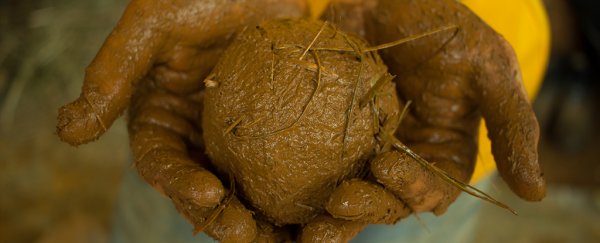Giant Convecting Mud Balls of the Early Solar System might sound like a horror movie from the 1960s, but as a recently published paper it's got fewer rubber alien suits and more evidence on how our planet might have formed 4.5 billion years ago.
A recent study suggests that as terrestrial planets like ours formed from a swirling maelstrom of dust and asteroid, heat would have melted the asteroid's ice before the material squeezed into solid rock. In other words, little Earth was more like a growing ball of mud.
Researchers from Australia's Curtin University and the Planetary Science Institute in Arizona took a closer look at the assumption that the rocks making up primordial Earth were more or less like meteorites that strike its surface today.
The current model paints a picture of a planet forming as meteorite-like rocks and dust aggregates under the force of gravity.
In particular, we're talking about a class of meteorites called carbonaceous chondrites that while relatively rare as far as falling space rocks go, are primitive samples of the early Solar System.
The composition of certain sub-types of carbonaceous chondrite is one of the biggest clues on how Earth formed.
"The unusual chemistry of CI and CM chondrites, abundant water, and mix of complex organics have led many to identify these meteorites as plausible terrestrial planet precursors or candidates for delivery of terrestrial volatiles," the researchers write.
Unfortunately, there isn't a whole lot of agreement on how water might have behaved in these rocks billions of years ago.
While the chemistry of some meteorites could be the result of small amounts of water trapped in tiny holes, other studies have indicated water might flow over long distances inside large asteroids.
A consistent model would help explain the hydrothermal properties of baby terrestrial planets like ours.
"The assumption has been that hydrothermal alteration was occurring in certain classes of rocky asteroids with material properties similar to meteorites," says Bryan Travis from the Planetary Science Institute.
And as such, there was a general assumption that the rock had to be solid, with small volumes of water ice restricted to tiny pockets.
So Travis and his colleague Phil Bland from Curtin University decided to go with a different idea. What if on accretion, tiny bits of dust, ice, and rock clung together without melting and cooling into a solid expanse?
Water could still melt in this highly porous body thanks to nearby radioactive elements, and even pull tiny particles along in their warm currents.
"Mud would have formed when the ice melted from heat released from decay of radioactive isotopes, and the resulting water mixed with fine-grained dust," says Travis.
This meant that embryonic Earth was a giant mud ball. More or less.
The researchers used what's called the Mars and Asteroids Global Hydrology Numerical Model (MAGHNUM) to carry out simulations based on this hypothesis, adapting the model to simulate the flow of water and minerals in ancient carbonaceous chondrite asteroids of various sizes.
The results line up neatly with the compositions of ancient chondrite meteorites that have been altered by water.
Ancient Earth might have consisted of dust and chondrules – tiny space rocks that have melted and cooled again – settling into a ball where liquid water was gradually squeezed up through muddy layers, dragging fine particles up to the surface as minerals are squeezed into a core in its wake.
For smaller asteroids, this process would have taken just a few million years until the asteroid solidified, meaning as Earth grew, it was peppered with meteors that acted more like mud balls than boulders.
But none of this is meant to explain why our planet is so wet in comparison to our neighbours.
The current best models still suggest icy objects from the outer reaches of the Solar System more than likely contributed most of our supply, and our mild temperatures and magnetic field kept it from being stripped away.
It's possible our mud ball planet was even wetter once upon a time, until another big object bumped into us and gave us a Moon in compensation. Fair swap.
As we probe various bodies in our Solar System and search for signs of exoplanets around distant stars we'll no doubt collect more evidence on the evolution of terrestrial objects like ours.
This research was published in Science Advances.
